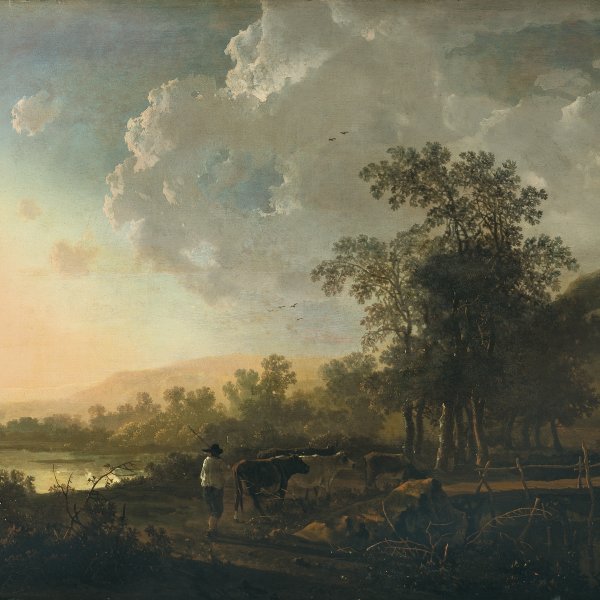Aelbert Jacobsz. Cuyp
Dordrecht, 1620-1691
Aelbert Cuyp was born in Dordrecht in 1620 into a family of artists: his grandfather Gerrit Gerritsz. was a noted craftsman and his father Jacob and uncle Benjamin Gerritsz. were painters. The surname Cuyp was used by Jacob Gerritsz. from 1617 and its use extended to the rest of the family. Aelbert first trained with his father and during the 1640s they worked together on a number of canvases in which Aelbert painted the landscape setting and his father executed the figures. During this period the artist made a trip around Holland and along the Rhine, executing drawings of Rhenen, Arnhem, Amersfoort, Utrecht, Leiden and The Hague. His first paintings were inspired by the “tonal” style of Jan van Goyen, Salomon van Ruysdael and Herman Saftleven II, although he revealed a preference for monochrome shades of yellow rather than the greys and browns characteristic of the tonal painters.
From 1645 Cuyp’s work manifests the pronounced influence of the Italianate painters, particularly Jan Both and Herman van Swanevelt. During these years he introduced effects of golden sunlight, steep viewpoints and tall, elongated trees, all typical of the school of Utrecht. In 1652 Cuyp again travelled along the Rhine and the Waal, reaching Cleve, Elten and Emmerich. During this trip he made numerous drawings that would provide inspiration for later compositions. Cuyp’s most frequently depicted theme is that of a landscape with animals, but he also painted marine views, still lifes and portraits.
In 1658 the artist married Cornelia Boschman, the wealthy widow of a local governor and granddaughter of the theologian Franciscus Gomarus. Cuyp abandoned painting after his marriage, devoting himself to business affairs and to church and civic matters. He was dean and official governor of the Reformed Church and governor of the most important charitable institution in the city, while from 1679 he became a member of the Tribunal of Southern Holland. Cuyp’s most important pupil was Abraham van Calraet, whose works have frequently been attributed to his master.
From 1645 Cuyp’s work manifests the pronounced influence of the Italianate painters, particularly Jan Both and Herman van Swanevelt. During these years he introduced effects of golden sunlight, steep viewpoints and tall, elongated trees, all typical of the school of Utrecht. In 1652 Cuyp again travelled along the Rhine and the Waal, reaching Cleve, Elten and Emmerich. During this trip he made numerous drawings that would provide inspiration for later compositions. Cuyp’s most frequently depicted theme is that of a landscape with animals, but he also painted marine views, still lifes and portraits.
In 1658 the artist married Cornelia Boschman, the wealthy widow of a local governor and granddaughter of the theologian Franciscus Gomarus. Cuyp abandoned painting after his marriage, devoting himself to business affairs and to church and civic matters. He was dean and official governor of the Reformed Church and governor of the most important charitable institution in the city, while from 1679 he became a member of the Tribunal of Southern Holland. Cuyp’s most important pupil was Abraham van Calraet, whose works have frequently been attributed to his master.





